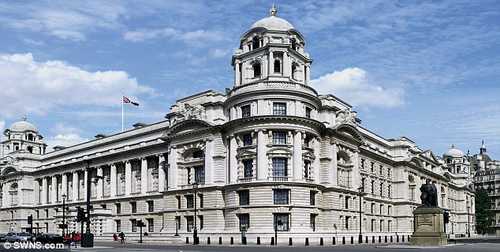
Modern/Post-War Photos
Corridors of Power.
SWNS.
No. 57, Whitehall, London - the "old" War Office Building. The War Office - the Government Ministry responsible for Great Britain's military affairs on land - has existed in some form since the late-17th century. After several changes of location, it finally settled at No. 57, Whitehall - a fine example of the late-Victorian/Edwardian boom in official building - in 1906, when this building was completed. It served as headquarters of the War Office and related offices until 1964 (when the WO was definitively replaced by the Ministry of Defence) and as a premises of that Ministry until 2013. Even before the building was completed it would have witnessed the intra-Army feuds between competing factions of the General Staff connected with the 2nd Anglo-Boer War. The height of the War Office's political influence probably came about during WW1, when it was the policy and administrative centre of the British Army's war work. At its height, the Office employed some 7,500 civil servants, most of them packed into this (admittedly huge) Whitehall complex. After the war, in a new age of "austerity" and military cuts, the staff fell to less than half that number. It was not just in terms of staffing that the WO declined. Even before WW1, politicians had begun to tire of having to conduct business through the Office, dominated as it was by Army generals and their cliques always threatening to break out in unproductive internal feuds. Consequently, starting with the formation of the Council for Imperial Defence in 1902, the politicians increasingly employed various Cabinet-based mechanisms to subvert and divert War Office influence over military affairs. By the time of WW2, this had become an established reality; Churchill assumed to himself the high policy functions of the WO by appointing himself Minister for Defence (although there was no actual "Ministry of Defence" at the time). Nonetheless, the WO remained as the administrative hub of the war effort, its many departments carrying out the practical work of managing all areas of the Army. In August, 2013, the Ministry of Defence (from its new headquarters, elsewhere) declared the old building "surplus to requirements" as part of its latest round of military cuts. The Grade II Listed building - with its 1,100 rooms, 2.5 miles of corridor, and 580,000 square feet of floor space, has just (Dec. 2014) been sold to the Hinduja Group for an undisclosed sum). While no details of development intentions have been announced, it is understood that the Hinduja brothers intend to develop the old building as a luxury hotel and/or luxury apartments. The sales agreement is understood to reinforce the building's Listed status to ensure that its essential features will be preserved, an understanding underpinned by the granting of a new 250 lease to the purchasers. "Ah, how all these things have passed away " Lost under Night's shadow, As if they never had been !" JR.
1517 Views
12/16/2014
